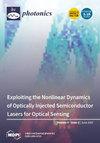高重复率 2.3-2.7 µm 声光调谐窄行激光系统,包括两个基于多晶 Cr2+:ZnSe、采用 2.1 µm Ho3+:YAG 脉冲泵浦的主振荡器和功率放大器
IF 2.1
4区 物理与天体物理
Q2 OPTICS
引用次数: 0
摘要
波长在 2 至 3 μm 之间的高平均功率窄线宽可调谐固体激光器是许多应用中极具吸引力的光源。本文报告了一种基于多晶 Cr2+:ZnSe 元素的窄线宽宽可调谐激光系统,该系统由重复脉冲 2.1 μm Ho3+:YAG 激光器泵浦,脉冲频率为数十千赫兹。为了提高激光诱导损伤阈值,采用了先进的 ZnSe 元素掺杂和表面改良程序,从而提高了 Cr2+:ZnSe 激光系统的输出功率。高平均功率激光系统由双主振荡器和功率放大器组成:Ho3+:YAG和Cr2+:ZnSe激光振荡器,以及Ho3+:YAG和Cr2+:ZnSe功率放大器。通过 Cr2+:ZnSe 主振荡器腔内的声光可调谐滤波器,可在 2.3-2.7 µm 范围内对输出波长进行广泛调谐。在 20-40 kHz 的脉冲重复率下,高质量光束的窄线宽运行得到了验证,平均输出功率高达 9.7 W。本文章由计算机程序翻译,如有差异,请以英文原文为准。
High-Repetition-Rate 2.3–2.7 µm Acousto-Optically Tuned Narrow-Line Laser System Comprising Two Master Oscillators and Power Amplifiers Based on Polycrystalline Cr2+:ZnSe with the 2.1 µm Ho3+:YAG Pulsed Pumping
High-average-power narrow-linewidth tunable solid-state lasers in the wavelength region between 2 and 3 μm are attractive light sources for many applications. This paper reports a narrow-linewidth widely tunable laser system based on the polycrystalline Cr2+:ZnSe elements pumped by repetitively pulsed 2.1 µm Ho3+:YAG laser operating at a pulse rate of tens of kilohertz. An advanced procedure of ZnSe element doping and surface improvement was applied to increase the laser-induced damage threshold, which resulted in an increase in the output power of the Cr2+:ZnSe laser system. The high-average-power laser system comprised double master oscillators and power amplifiers: Ho3+:YAG and Cr2+:ZnSe laser oscillators, and Ho3+:YAG and Cr2+:ZnSe power amplifiers. The output wavelength was widely tuned within 2.3–2.7 µm by means of an acousto-optical tunable filter inside a Cr2+:ZnSe master oscillator cavity. The narrow-linewidth operation at the pulse repetition rate of 20–40 kHz in a high-quality beam with an average output power of up to 9.7 W was demonstrated.
求助全文
通过发布文献求助,成功后即可免费获取论文全文。
去求助
来源期刊

Photonics
Physics and Astronomy-Instrumentation
CiteScore
2.60
自引率
20.80%
发文量
817
审稿时长
8 weeks
期刊介绍:
Photonics (ISSN 2304-6732) aims at a fast turn around time for peer-reviewing manuscripts and producing accepted articles. The online-only and open access nature of the journal will allow for a speedy and wide circulation of your research as well as review articles. We aim at establishing Photonics as a leading venue for publishing high impact fundamental research but also applications of optics and photonics. The journal particularly welcomes both theoretical (simulation) and experimental research. Our aim is to encourage scientists to publish their experimental and theoretical results in as much detail as possible. There is no restriction on the length of the papers. The full experimental details must be provided so that the results can be reproduced. Electronic files and software regarding the full details of the calculation and experimental procedure, if unable to be published in a normal way, can be deposited as supplementary material.
 求助内容:
求助内容: 应助结果提醒方式:
应助结果提醒方式:


